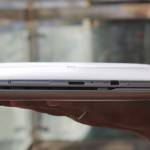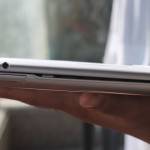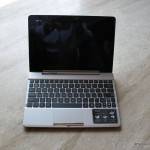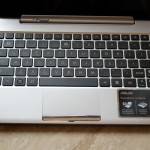Tablets are good companions. Casual web browsing, gaming, media playback and basic document editing, everything is possible with tablets and that’s the reason why users tend to prefer a tablet over a regular desktop or a laptop. But what if you want to do a little bit more with a tablet? Writing a 300 word article can be a difficult proposition with on-screen keyboard. This is where Asus Transformer Pad comes into picture. It is a tablet with convenience of a keyboard.
Courtesy Asus India, I had a chance to play around with Asus Transformer Pad TF300 for a while and see what does a convertible tablet has to offer. So let’s begin with Asus Transformer Pad TF300 review.
Design Perspective
Asus Transformer Pad TF300 has a 10.1″ inch IPS display protected by a reinforced glass in front of it with plenty of bezel around the edges. Some might argue that a lot of space is wasted but for a 10″ inch display, you do need some amount of space around the display in order to avoid accidental touches. At the back, on the top there’s a camera positioned to the center and a rear speaker to the left. Around the sides there is a 3.5 mm audio jack located at the top right accompanied by volume rocker at the top left with a micro-HDMI and microSD card slot below that. The power/screen on-off multi-purpose button is on the top left. In short there’s nothing out of the world about the design of the device.

Coming to the build quality, Asus Transformer Pad TF300 has a plastic body with punched grooves at the back of the device. The good part is, looks can be deceiving. Transformer Pad does portray a metallic look from a distance but once you get your hands on it, you know about it. It isn’t the most sturdy device around (there’s a bit of flex) but unless you are planning to be careless about it, it isn’t going anywhere.
Display
Asus Transformer Pad TF300 sports a 10.1″ inch IPS TFT LCD display with resolution of 1280 x 800. Roughly 150 ppi of pixel density is on the lower side in the age of retina displays but activities like web browsing, reading text, watching movies can be done without any noticeable difference. The difference emerges once you look at the screen from a very close distance.

The viewing angles and outdoor visibility are perfectly acceptable for an IPS display, there’s isn’t too much reflection under natural light. However let me warn you against comparing it with Super AMOLED display. IPS and AMOLED have their own set of benefits, which I won’t be discussing here. [Read this wikipedia article for information on this]
Keyboard – Does It Really Matter?
Without the keyboard dock, Asus Transformer Pad is just a tablet. It is the keyboard which adds a certain advantage to the tablet aspect. To answer the question in heading, Yes, Keyboard really matters and it performs. Apart from usability it also supplies additional power to the tablet with an extra battery located under the keyboard. So that’s a double advantage.
Connecting the tablet to the keyboard dock and taking it out is very easy, all you have to do is to slide the shiny switch to pull it off and place it on dock with slight pressure to re-attach. The 2 step dock/un-dock procedure is as simple as it gets.

About the keyboard itself, it is certainly a plus point if you intend to compose text on the move and/or prefer hardware keys for using the tablet rather than touch panel. Plus Asus has introduced some dedicated keys to control settings like brightness, etc. Once connected, the keyboard does manage to deliver a near-laptop experience.
Camera
If a tablet is capable of shooting images with decent quality, good enough for sharing on facebook, twitter, etc, I consider it good. Asus Transformer Pad is no exception to this rule. It comes with a 8 MP camera with auto-focus (no LED flash). Absence of LED flash means that night time photography is out of the picture (and indoor photography to some extent). No point in even talking about it. The day time camera quality is a mixed bag. Actually it depends on the amount of natural light available. There are times when you get nice, crisp shots out of it and others when the images looks utterly washed out.
The saving grace in camera department is that it is capable of capturing good pictures under right lightning and the fact that there is a 1.2 MP front-facing camera for video calls, etc.
Storage Capacity
Seeing purely from a tablet point of view, Asus has been quite generous providing 32 GB of on-board storage complemented by a microSD card slot for additional storage. Plus you have access to the usual android cloud storage apps like Box, Google Drive, Dropbox, etc. This essentially means that you have ample of storage at your disposal for storing songs of your liking, movies of your preference and a bunch of documents for offline editing.
Performance
First the specification, Asus Transformer Pad 300 comes with NVIDIA Tegra 3 chipset with a 1.2 GHz quad-core ARM Cortex-A9 processor along with 1 GB of RAM. It is also well connected with Wi-Fi 802.11b/g/n (2.4 GHz band), Bluetooth 3.0, A-GPS, 2G (GSM 900, 1800), 3G (UMTS 2100) and Android Ice Cream Sandwich pre-loaded.
Four cores clocked at 1.2 GHz clubbed with 1 GB RAM is more than required for mundane tasks. As a matter of fact there aren’t applications capable of truly utilizing the quad core nature of processor. This means that operating the tablet is a breeze. No lags, no slow-downs of any sort.
For most devices the media playback is all about installing MX Player and getting started with watching videos. But with NVDIA’s Tegra 3 chipset inside, things get a little different. Although I was able to play the usual 720p and 1080p videos without any problem courtesy Tegra 3 and dedicated video decoding processor but the interesting part here is that it was also able to play 4K Ultra HD resolution! This doesn’t have direct implication on the current media playback but it does prove the prowess of the processor and the fact that it is future proof!
Battery Life
Asus claims the tablet plus keyboard dock can last 15 hours without needing a charge, for me it lasted for roughly 12 hours. Of-course the battery longevity varies based on usage pattern but for an average, causal user I am confident that the tablet will last a day.
Conclusion
The combination of a tablet-cum-keyboard works in form of Asus Transformer Pad TF300. You get to enjoy the portability aspect of a tablet and all the goodness of Android along with it, whereas the Keyboard dock further enhances the usability of the device. It’s a good buy indeed baring the disappointing single speaker output and a mediocre plastic build quality. The keyboard dock, camera (to some extend), battery life, storage all work in its favor.




























